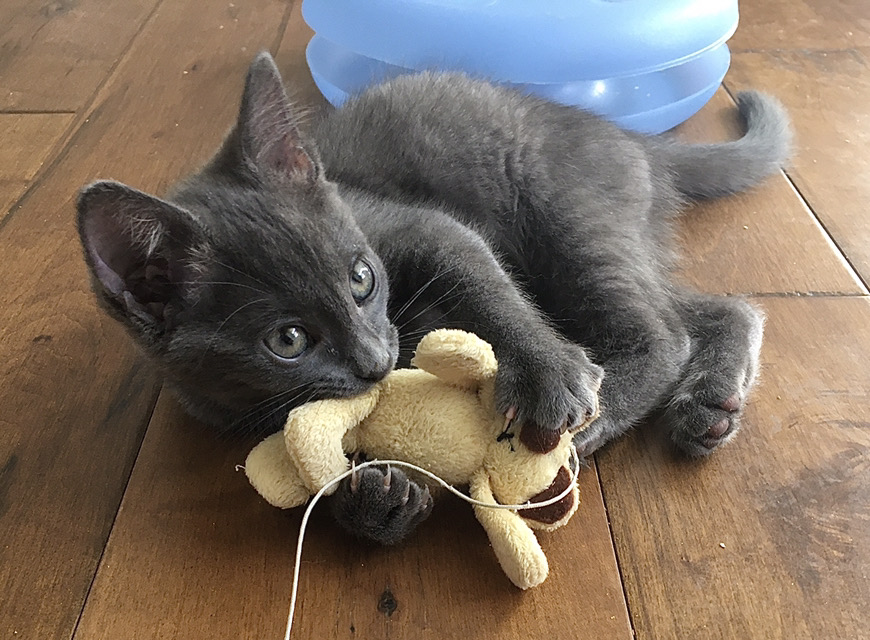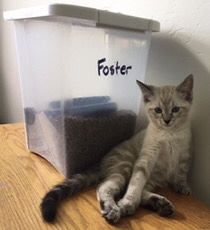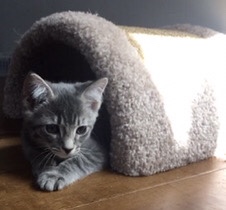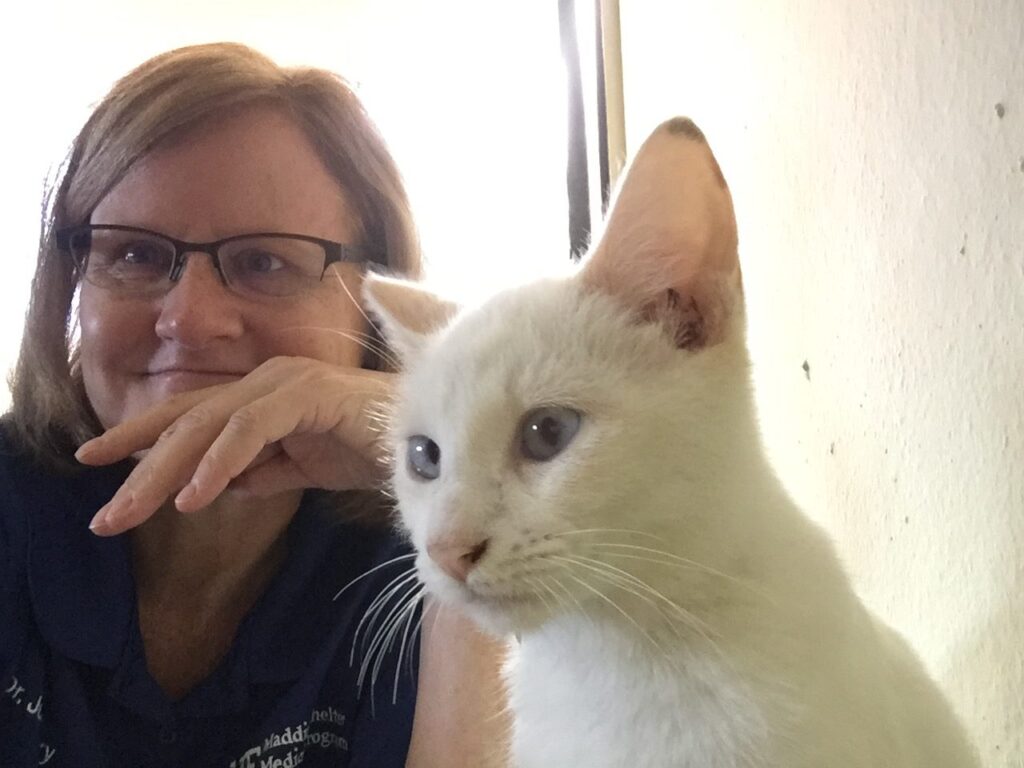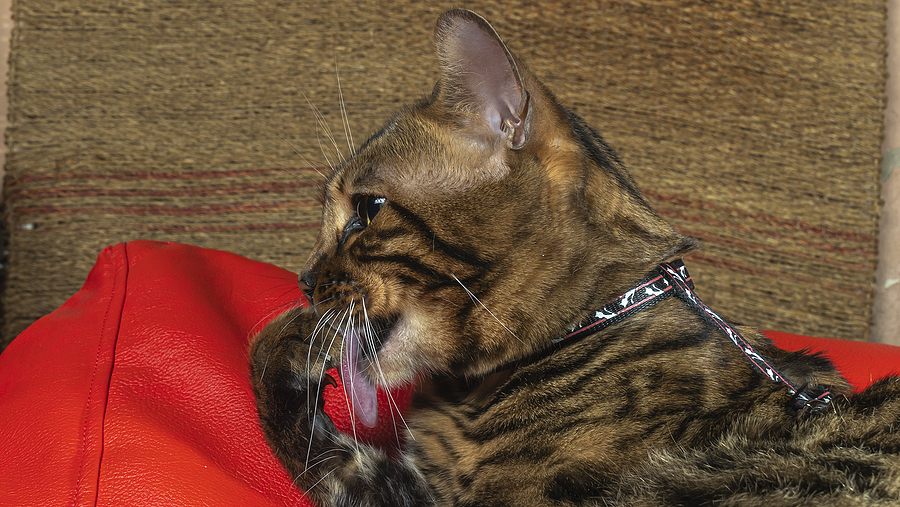
According to feline behaviorists, neither age and nor gender are mitigating factors in compulsive behavior. However, wool sucking along with repetitive meowing has been found to be more common among so-called oriental breeds such as Siamese and Birman cats.
Dr. Nicholas Dodman, president and CEO of the Center for Canine Behavior Studies (they study feline behaviors too), who authored The Cat Who Cried for Help: Attitudes, Emotions, and the Psychology of Cats, ranks excessive grooming, known as psychogenic alopecia, as the most common abnormal repetitive behavior among cats generally. Wool-sucking and pica, the ingesting of weird objects, come in second, and, lastly, Dodman says that feline hyperesthesia, often referred to as twitchy skin syndrome, which results in a cat launching unprovoked attacks or suddenly appearing startled and then dashing away, is often also considered to be a compulsive disorder.
Psychogenic Alopecia
Cats are often mislabeled as independent, selfish, and uncaring creatures. In fact, the opposite applies; they are very caring and empathic and very conscious of their surroundings. Thus, all kinds of changes and conflict in their lives can evoke stress and anxiety. One common reaction to their personal situation is over-grooming.
“Feline psychogenic alopecia may begin as a displacement behavior arising from situations of conflict, frustration, or anxiety, but might in time become compulsive,” says Dodman. In an article published on the CCBS website, he spells it out: “The diagnosis of psychogenic alopecia as a compulsive disorder is reserved for those cases in which no underlying medical problem is evident.
“In most cats, over-grooming resulting in alopecia where they have pulled out chunks of fur and licked their skin raw, has an underlying skin disorder such as an allergic reaction to fleas or other external parasites. Inhalant allergies and even food allergies could be the root cause, and it’s important to seek veterinary assistance to rule all these causes out before the excessive grooming can be diagnosed as behavioral.”
In her book Cat vs Cat, Pam Johnson-Bennett says: “Because cats are such meticulous groomers, a cat parent may assume that the behavior is nothing unusual. Displacement grooming is a normal way for cats to recue their anxiety and calm themselves during or after a stressful situation. You may see this after a cat miscalculates a jump and falls to the floor. Although it may look as if she is embarrassed, it has more to do with her need to get her bearings because she was caught off-guard. Also being denied something she wants like getting on a counter and being repeatedly removed and even scolded can prompt displacement grooming,” she explains.
However, Johnson-Bennett points out that it’s easy to dismiss these small stressors. So, they build and suddenly the cat has huge bald patches!
“Interactive play comes to the rescue yet again,” she writes. “Use it to boost confidence and release endorphins. Pouncing and play games offer mental and physical stimulation.” And she warns, “if you see your cat sitting in a particular position before she’s about to start compulsively grooming, get out the wand and other toys and play instead!”
But play may not be the complete answer. Sometimes medication is necessary to help break the cycle.
Wool Sucking and Pica
Cats who love to chew on a blanket or a piece of cloth may be likened to young children who walk around sucking on pacifiers or hugging security blankets. This behavior often occurs in kittens who have been removed from their mothers too young and have not had the opportunity to nurse until their mothers properly weaned them. Soft, cuddly fabrics become a substitute for mama cat.
The sucking itself is not a problem, but if the sucking turns into chewing and swallowing, it can lead to problems such as gastrointestinal obstructions. Boredom and loneliness, especially when cats are left alone all day, can lead to separation anxiety and can prompt them to turn to material sucking and chewing to soothe themselves. This can lead to pica, the ingestion of material, plastic, and other non-food items.
Often the urge to suck on fabrics subsides as a kitten becomes an adult. However, problematic chewing can recur in adulthood as a defense mechanism for dealing with a stressful situation such as household tensions between cats or separation anxiety.
In the case study on compulsive wool sucking published in the Journal of Veterinary Behavior with which Dodman was involved, two hundred and four Siamese and Birman cats enrolled in the study were tracked for various physical characteristics, current and previous medical conditions, presence of an abnormally intense appetite, and environmental factors. The research ultimately showed that early weaning and small litter size were associated with increased risk of wool-sucking in Birmans only. The presence of a medical condition was associated with increased risk of wool-sucking in Siamese cats. The presence of an abnormally intense appetite was seen in all affected cats. However, no relationship was found between physical characteristics and wool-sucking in Siamese or Birman cats.
Dodman also points out that medical conditions that can trigger abnormal ingestion of inappropriate material include hunger, nutritional deficiencies such as anemia or inadequate dietary fiber, diabetes, or tumors.
Feline Hyperesthesia
“This is a complicated behavioral condition with some features that appear compulsive and others that appear frankly neurological,” says Dodman. “Because of the overlap between symptoms of other issues, it is thought to possibly be a form of partial seizures with compulsive components. There is an apparent sensitivity to touch (episodes may be induced by stroking along the spine), which can trigger attacks and accounts for the name of this syndrome,” he further explains.
Feline hyperesthesia is often referred to as rippling skin syndrome, rolling skin syndrome, or twitchy skin syndrome. Signs include dilation of pupils, excessive skin rippling, and frenetic self-directed grooming that may result in hair loss. Grooming may be so intense it may manifest as self-directed aggression often focused on the tail (tail-chasing).
Affected cats may emit excessive and unusual vocalizations and appear to hallucinate (act afraid of their tail) and run away. They may appear “manic” (excited look, frantic running, jumping) and are frequently extremely sensitive to touch. Sometimes aggressive bouts are preceded by attention-seeking and enhanced affection to people. Affected cats are often anxious and restless, constantly wandering and pacing. Sometimes the aggression can be directed at people.
“Almost all aggressive behavior can be traced back to a specific cause. Idiopathic aggression – the name given to totally unprovoked aggression that has no known cause — is rare,” says Johnson-Bennett. “This type of aggression is too difficult and too dangerous for a cat parent to try and correct without professional help.”
Helping Owners
Advise cat parents to be on the lookout for excessive sucking or chewing on fabrics, behaviors such as hunting and pouncing at unseen prey, running and chasing, paw shaking, freezing, excessive vocalization and a manic look, self-directed aggression such as tail chasing, and overgrooming to the point of pulling out fur in patches. While these may start out as signs of conflict or anxiety, if not attended to, they can become compulsive disorders over time.
Ask cat parents about conflicts in the home and whether there are ways to eliminate it. They may need a referral to a veterinary behavior specialist who can help them to recognize and manage such conflicts, whether they are between cats and humans, cats and other cats, or cats and other animals in the home. Other things to try:
- Environment enrichment may help to distract a cat from compulsive behavior.
- A tall cat tree or cat condo strategically placed near a window helps keep cats engaged.
- A fountain not only attracts a cat to drink water but also adds sound and motion enhancements to the environment.
- Offer the cat an indoor garden of safe plants to nibble on, ideally placed near a water fountain or water dish.
- Wand toys allow cats to chase, pounce, and play.
- For cats who enjoy exploring, leash-training can provide safe outdoor excursions. A catio is another option that can provide distractions from self-harming.
- Suggest puzzles that can be filled with treats or a portion of a meal.
- If wool sucking or over-grooming are involved, a diet that includes a high-fiber kibble may help redirect the cat from compulsive behaviors to focus on nibbling. A veterinary nutritionist may have suggestions.
This article was reviewed/edited by board-certified veterinary behaviorist Dr. Kenneth Martin and/or veterinary technician specialist in behavior Debbie Martin, LVT.


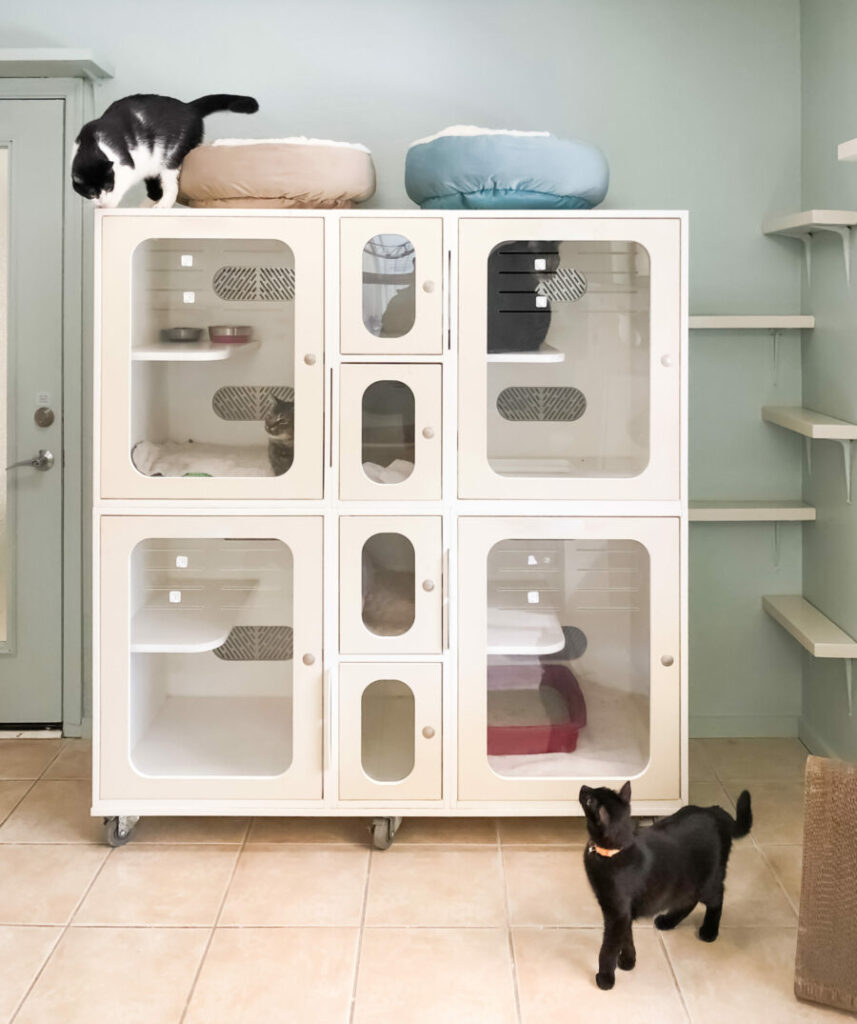
 “If you can see a cat being a cat – really climbing and scratching and playing and being a cat, not just hiding in a cage – you can picture that cat in your home,” she said. “You can get to know their personality better.”
“If you can see a cat being a cat – really climbing and scratching and playing and being a cat, not just hiding in a cage – you can picture that cat in your home,” she said. “You can get to know their personality better.”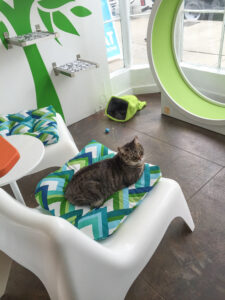
 If a shelter only has a closet that’s used for out-of-cage time and meet and greets, she says to avoid just putting a folding chair inside.
If a shelter only has a closet that’s used for out-of-cage time and meet and greets, she says to avoid just putting a folding chair inside.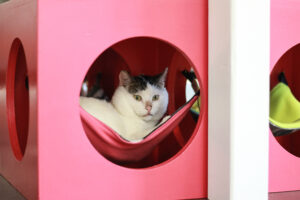 Often working with
Often working with 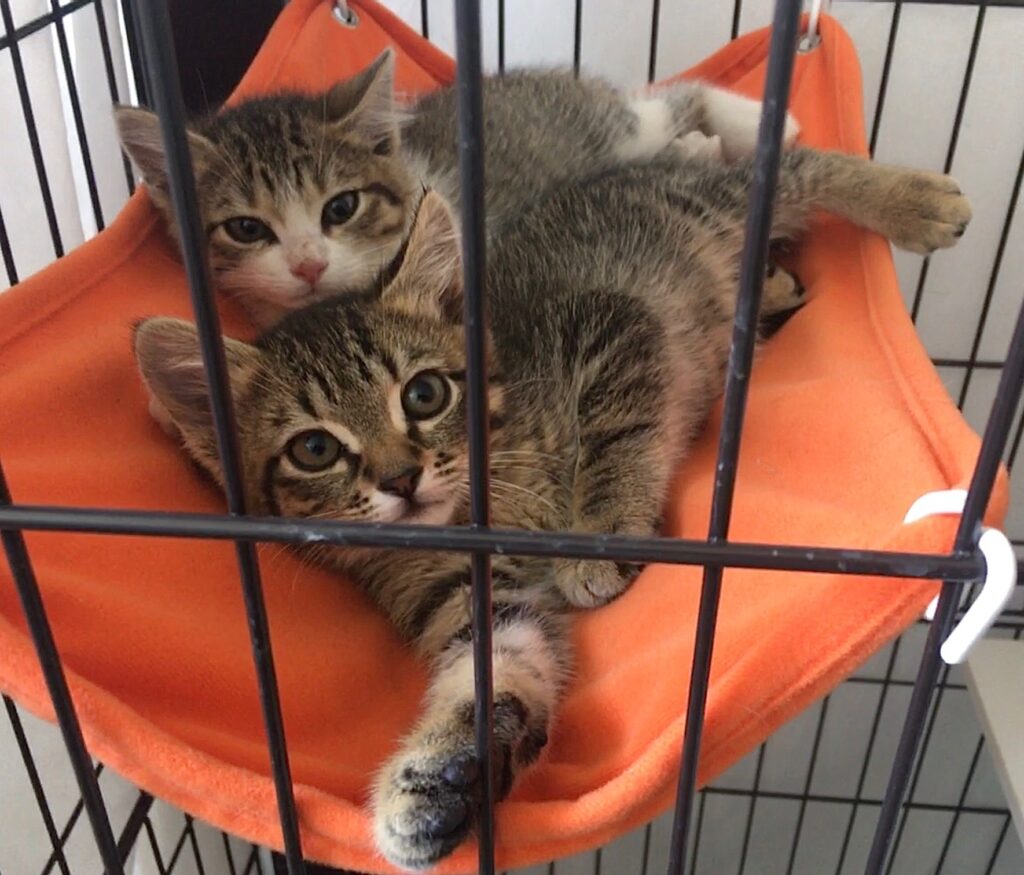
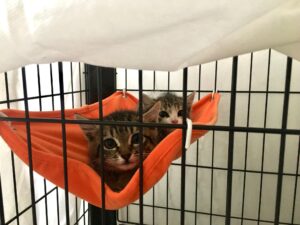 their crate and train them together. A more frightened kitten may see her bolder littermate getting treats and decide you’re not so bad after all. On the other hand, it may incite aggression between kittens so observe carefully to determine whether to train them together or separately.
their crate and train them together. A more frightened kitten may see her bolder littermate getting treats and decide you’re not so bad after all. On the other hand, it may incite aggression between kittens so observe carefully to determine whether to train them together or separately.